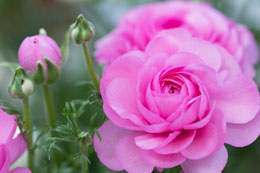The basic ranunculus care and maintenance instructions are centered around providing the essential growth requirements. Remember that ranunculus plants grow best in areas, where spring season is cool and long, and winter temperature is not extremely cold.

While starting a flower garden, all we can expect is vibrant blooms filling up the beds and brightening the landscape. Ranunculus is known for the same attributes. Yes, it produces bright colored blooms in shades of white, yellow, orange, pink, purple, red and some cultivars have multicolored petals. Unfortunately, it comes with a tag of difficulty in cultivation, and many hobbyists avoid planting it in gardens. The truth is, ranunculus care is challenging in cool areas, but not for moderate warm regions.
Ranunculus Plants: Growing Guide
The term ranunculus is colloquially used to refer to both the common name and generic name of herbaceous plants, which belong to family
Ranunculaceae. They are mostly perennial plants, while a few are annuals and biennials. Some appreciable attributes of ranunculus are lacy leaves, long and upright stems, heavy blooms, delicate petals and long shelf life. In order to make your task for caring for ranunculus simple, highlighted below are the basic cultural requirements for growing this perennial flowering plant.Hardiness Zones:
USDA zones 8-11
Propagation Method:
Woody, clawlike bulbs
Bulb Preparation:
Soaking roots in warm water
Planting Time:
Spring and fall
Preferred Soil:
Well-drained, fertile soil
Light Factor:
Grows best in full sun
Temperature Factor:
Cool temperature
Water Requirement:
Moderate irrigation
Fertilizer Application:
Light fertilization
Plant Problems:
Aphids, fungal attacks and mollusks
How to Care for Ranunculus Plants?
If you are interested in larger blooms, then choose the Tecolote or Jumbo ranunculus bulbs. For cool climatic regions (zones 4-7), it is best to grow ranunculus indoors, about 3 months before the last frosting. Select healthy bulbs and plant in large pots (preferably 6 inches in diameter) about 1 inch below the soil, with the root tips pointing down. For growing it in warmer areas (zones 8 and above), ranunculus bulbs are planted directly in outdoor garden beds in spring, with a spacing of 4-6 inches between them.
- Hoping that you have grown ranunculus plants in sunlit areas and soil with no drainage problems, they will grow luxuriantly. Indoor ranunculus care involves placing the potted plants in bright light, or in the windowsill.
- If the indoor plants lack vigor or appear weak, perhaps it is because of insufficient light. For such a case, consider installing artificial lights to restore normal growth. Make sure they are placed near to the west or south facing windows.
- Coming to the temperature part, it withstands 10-20°F, and not below this range. Accordingly, make the necessary arrangements to protect ranunculus plants from heavy frosting. For container plants, you can bring them indoors.
- The most crucial part in ranunculus care is watering. Yes, keeping the soil moist but not wet is the trick to grow healthy ranunculus plants. Too less moisture and they will wither away, while overwatering increases root rotting.
- Ranunculus cannot tolerate heavy fertilization. Of course, they do require fertile soil and nutrients for producing maximum flower buds. You can use correct doses of bulb fertilizer during the active growth season and just before the blooming period.
- After bloom care for ranunculus plants is the same as before. Do not remove the leaves, instead retain them as they are. The foliage synthesizes food and prepares the plants for next year's flower production. Continue watering to promote photosynthesis.
- After the flowering season is completed, i.e., in summer, the leaves will become yellow. This indicates that the plants are entering dormancy period. At this phase, remove the drying leaves and keep the bulbs undisturbed. They will sprout during favorable weather conditions.
- In case ranunculus is subjected to stressful conditions, it becomes weak, and disease and pest infestations are most likely to occur. The common ranunculus problems include infestations of powdery mildew, rust, aphids, spider mites and snails.
The fall planted ranunculus blooms in spring time, while those planted in spring produce copious blooms in June and July. You can collect the long stemmed ranunculus blooms for making flower bouquets, and also for beautifying home indoors and offices. The ranunculus flowering season lasts for 1½ months, and the plants look awesome during this period. Many people prefer removing the spent blooms to conserve moisture and nutrients for the developing flower buds.






 While starting a flower garden, all we can expect is vibrant blooms filling up the beds and brightening the landscape. Ranunculus is known for the same attributes. Yes, it produces bright colored blooms in shades of white, yellow, orange, pink, purple, red and some cultivars have multicolored petals. Unfortunately, it comes with a tag of difficulty in cultivation, and many hobbyists avoid planting it in gardens. The truth is, ranunculus care is challenging in cool areas, but not for moderate warm regions.
While starting a flower garden, all we can expect is vibrant blooms filling up the beds and brightening the landscape. Ranunculus is known for the same attributes. Yes, it produces bright colored blooms in shades of white, yellow, orange, pink, purple, red and some cultivars have multicolored petals. Unfortunately, it comes with a tag of difficulty in cultivation, and many hobbyists avoid planting it in gardens. The truth is, ranunculus care is challenging in cool areas, but not for moderate warm regions.